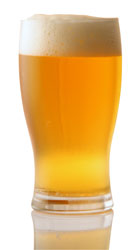
Pushing a Yeast Past Predicted Attenuation
#1

Posted 02 May 2010 - 04:16 AM
#2

Posted 02 May 2010 - 04:51 AM
Nice work. To answer the title of your posting its yes you can. Personally I would view that as a positive for all the things you did to make this beer a good beer to ferment. I have not recently compared attenuation % for the yeasts and beers I have brewed but rather wanted the FG to fall within the suggest FG range for whatever style I am making. Unless your FG gave your beer a mothfeel or taste you didn't like I would be happy that the yeast attenuated more than the stated Wyeast site. Those are not definite numbers I am sure more or less a guide on what to expect. I know that a low mash temp that you described would aid in a low FG like you got too. Again nice job I would be happy with how well you got this one fermented if I were you. Last year I brewed a Belgian Blonde, mashed at around 148. I pitched White Labs 550 hoped for a FG of 1.010-.012 and that sucker chewed it down to 1.002. Its was a very alcohol % beer but it was well recieved by others and me. That was definitely a beer that attenuated further than I had expected. Cheers Zym!!I recently brewed a fairly light beer and used Wyeast Scottish Ale yeast to ferment it. The beer had an OG of 1.05 and should have been pretty fermentable b/c I mashed low at 147-149F. The wyeast website says this yeast will attenuate 69-73%. I saw an attenuation of about 82% (FG = 1.008). Fermentation temperatures were in the low 60s. I did make a starter with a stir plate and I oxygenated the wort prior to pitching the yeast.ETA: I can't taste any off flavors in the gravity sample.
#3

Posted 02 May 2010 - 05:38 AM
#4

Posted 02 May 2010 - 06:13 AM
#5

Posted 02 May 2010 - 06:24 AM
#6

Posted 02 May 2010 - 06:32 AM
How sure are you that your mash temp is correct and uniform?I'm not sure why, but my beers always seem to attenuate some amount more than the published predicted range, even when I mash as high as 155 F. And I almost always ferment at the lower end of the recommended temperature range. I just take that into account when I'm formulating a recipe.
#7

Posted 02 May 2010 - 07:10 PM
#8

Posted 03 May 2010 - 03:10 AM
I've actually been on both ends of the spectrum. This time I fermented out more than expected (happened a few other times as well but not to this extent over the manufacturers estimated specs) and I have certainly attenuated less than expected (high mash temps, carapils, etc.).If you want maximum attenuation, try to achieve most of your conversion around 146dF, and for more diastatic action you can ramp up from there. With judicious use of sugar and ramping up of temperatures near the end of fermentation getting over 90% apparent attenuation even with relatively high gravity worts is no longer much of challenge.
0 user(s) are reading this topic
0 members, 0 guests, 0 anonymous users










